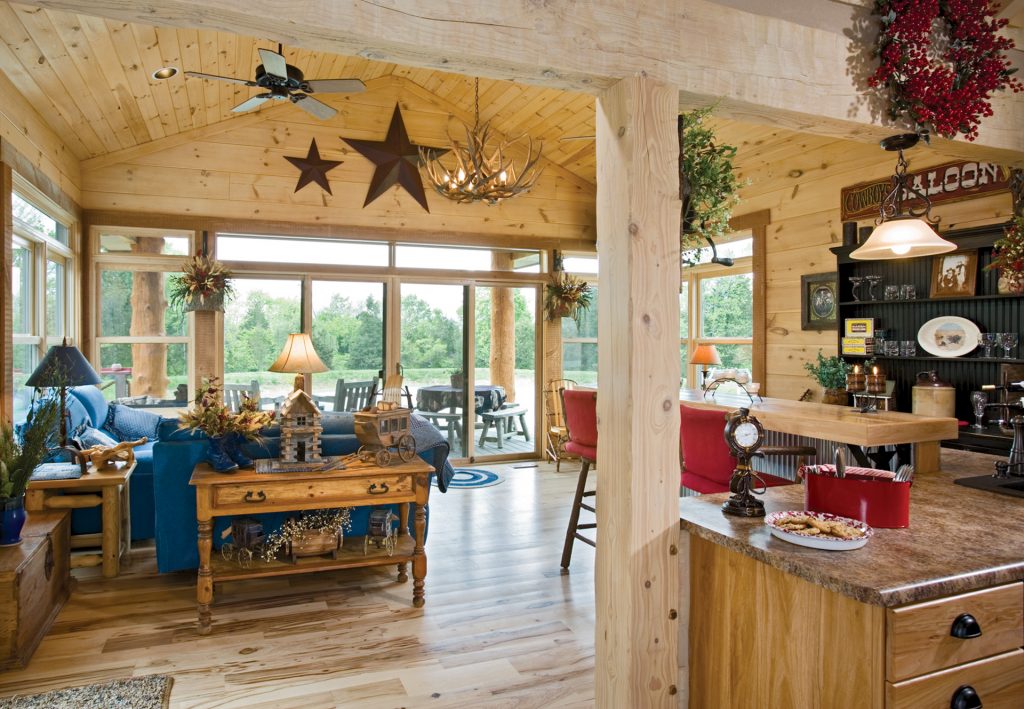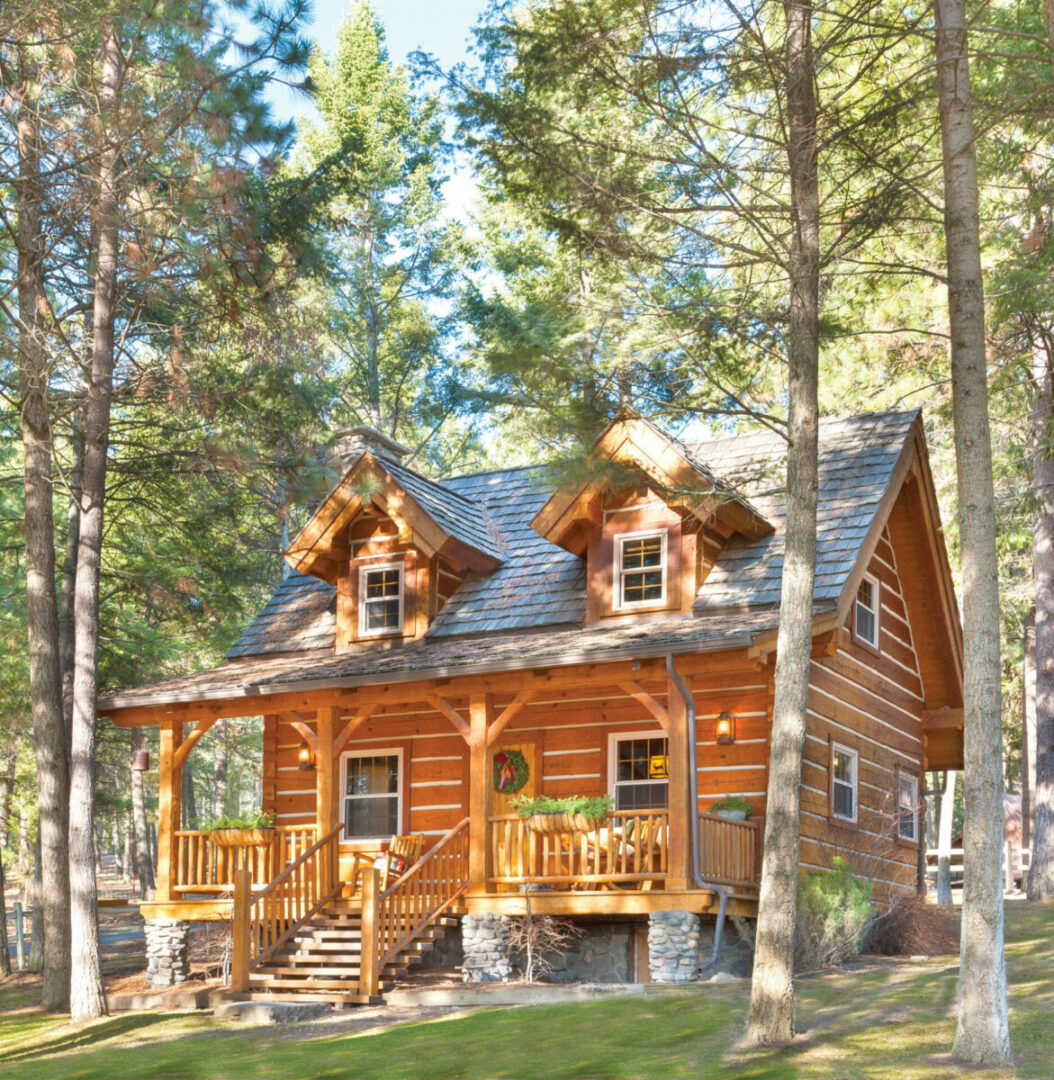Your land, lifestyle, and budget play equal parts in determining the ideal floorplan for your home.
Building a home from the ground up can be a dream come true: the chance to configure, room by room, the home you always wanted just the way you always envisioned it. You may have a file full of magazine clippings or favorite ideas bookmarked on your computer. But when the time comes to commit to a floorplan, it’s hard to know where to start. A log or timber frame home is a major investment, so it’s worth taking some time to make sure the home of your dreams truly delivers.
Log and timber companies offer many standard or “stock” floorplans, based on their experience building homes and what has worked well for customers over the years. These plans suit a spectrum of lifestyles and budgets, so you’re likely to find one that appeals to you in their catalogue. Still, every project is different—with variables like climate and property features coming into play—so some customization of stock plans or even a fully custom floorplan might be the best option.
Where to Start?
One of the most important elements to consider when selecting a floorplan is your property. Does your property lend itself to a sprawling ranch-style home? Is there a slope that would better accommodate a daylight basement? Are there other land or water features that might dictate the layout of your home, such as a view or exposure?
Another critical element to keep in mind is your lifestyle. Will you have grandchildren filling up a bunkroom or are you looking for a quiet, cozy getaway? Perhaps you’re planning for retirement and want to stick to a single-level home. And don’t forget budget. There are design strategies that can help you keep costs down without sacrificing style.
Finally, think about what style of home you are drawn to. An open great room that connects to the kitchen is popular in log and timber homes, but if your personal style is more traditional you might prefer a different layout. “Every stock plan obviously has to contain the essential living areas but also contain character and appeal,” says Stephen Brumfield, national director of sales and marketing for Log Cabin Homes in Rocky Mount, North Carolina. “Without keeping style and flow in mind when creating a floorplan, home interiors would simply be boring.”
Stock versus Custom
Instead of thinking of stock plans and custom plans as an either-or proposition, think of them as points on a spectrum, with plenty of options in between.
Once you know what you’re looking for, take some time to browse through the stock plans offered by your log and timber producer, and work with your representative there to determine whether they offer a stock plan that meets your needs or if you’ll need a level of customization. “On occasion we find a customer who loves a certain style of home but wants something either much smaller or much larger than one that we have in our stock plans,” says Brumfield. “Once the idea is put on paper our in-house CAD (computer-aided design) department creates the plans and makes any modifications needed for structural integrity or space requirements.”
Log Cabin Homes offers more than 80 standard plans and is adding more choices all the time. The company can also customize any of the plans, and offers free quotes on custom designs with no obligation to purchase. “Most log home buyers will only buy and build a log home once,” says Brumfield. “It is better to create or modify a plan the way you want it.”
PFB Custom Homes refers to their standard plans as conceptual designs and thinks of them as a starting point rather than ready-to-build. “Our floorplan gallery is made up of a variety of mountain home styles,” says Stephanie Johnson, marketing manager for PrecisionCraft Log & Timber Homes in Meridian, Idaho. “This gives people an idea of what is possible and can inspire their own version of the plans. Even if someone comes to us and says they are in love with one of the plans, we start their project from scratch and draw their home to specifically fit their land, needs, and budget parameters.”
True Collaboration
Your log and timber home company is there to make the process as easy for you as possible, while making sure you end up with a home that has a sound design. Rely on their expertise! “We have received requests for custom plans and quotes in many ways over the years,” says Brumfield. “Whether the idea is sent to us sketched on a napkin or precisely drawn on draft paper we take even the most basic of ideas, dreams, and needs of our customers and develop them into a floorplan that is functional and sound.”

Standard log home plans can easily be modified to add more living space to a room. Photo by Roger Wade
With a computerized design process, there’s room for flexibility, so it’s not uncommon for a preliminary design to be modified more than once. Don’t be afraid to ask for changes! Whether you want to add square footage or even flip rooms around, your log or timber home company should be able to accommodate your wishes.
“For us, amazing design is a cornerstone of what we offer our clients, so our in-house team is tasked with coming up with new ideas on a regular basis,” says Johnson of PrecisionCraft’s in-house designers M.T.N. Design. “We rely on their creativity and knowledge of current trends to showcase new ideas to potential clients and inspire the next custom home.”
Your costs and the level of expertise available may depend on who you are working with, whether that’s an architect, an independent draftsman, or an in-house design team. “Make sure you know what level of design services is offered and what you can and cannot change,” advises Johnson, noting that the designer’s abilities will naturally impact the final project.
“For PrecisionCraft it all starts with the client and their vision,” says Johnson, who says most clients come in with a fairly good idea of their likes and dislikes. “The land and views have a big role and we pay a lot of attention to their overall budget so we can design a house they can actually afford to build.” The design staff works directly with the client to ensure there are no gaps in understanding, from the first sketches to final construction documents.
At the end of the day, everyone on your home design team wants you to end up with the home of your dreams and will work with you to make sure you end up with just the right floorplan, whether that’s an existing floorplan, a fully custom design, or most likely, something in between.

